
Dauphin Island Birding Marathon
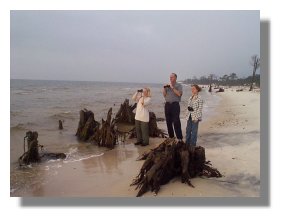 |
By Thomas H. Wilson, Ph.D. BIO 401 Ornithology |
Birding is the most popular participation sport in the Western World, and the two students in my Spring, 2000, Ornithology class certainly exhibit the interest, enthusiasm, and energy needed for this demanding activity. After three weeks of classroom “bird immersion” where we spent hours learning to identify approximately 200 birds from slides, field guides, VCR tapes, the Web and local field trips, we went for the big adventure…a birding marathon to Dauphin Island and Mobile Bay.
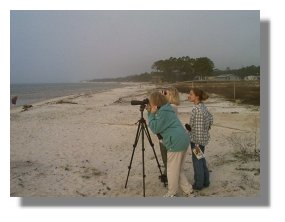 |
On Friday, February 18, at 1:00 p.m. Amber Bailey, Kelly Shipman, Doris Wilson (Financial Aid Director and my wife) and I loaded the Lincoln and headed for Dauphin Island. We saw our first shorebird at Cedar Point near the Dauphin Island bridge. It was a Brown Pelican atop a pier post. Arriving at the Dauphin Island Sea Laboratory, we parked and immediately started our adventure. |
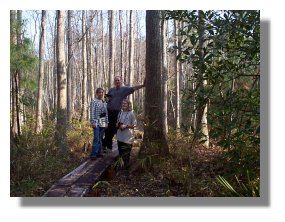
Within minutes we spotted Laughing, Ringbilled, and Herring gulls along with Caspian and Foresters terns. Ruddy Turnstones, Mallard ducks and a lone Oyster Catcher were in a saltmarsh eddy near the Sea Laboratory. Brown Pelicans, Double Crested Cormorants and scores of immature and winter phase gulls lined the rip-rap jetty wall beside the public launching area. |
We admired Fort Gaines which is beside the Sea Laboratory and continued our rush to see as many birds and possible before dark. A family of Hooded Mergansers challenged us. We finally made the correct identification when the fancy adult male member popped up and displayed his white hood.
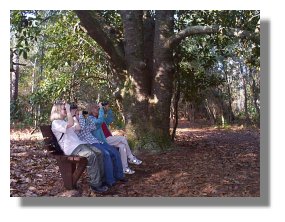 |
The beautiful sunset was followed by a spectacular full moon … what a grand ending to our first few hours of birding. |
In route to Dauphin Island, we bought a heap of fresh jumbo Brown Shrimp from the Southern Seafood Market in Saraland. This is my favorite seafood market in all of Alabama. We all participated in preparing a royal seafood feast. Two boxes of Zatarain’s Crab Boil, one sliced lemon, one tablespoon of cooking oil (makes the shrimp peal better) and a palm of salt were added to the pot of water. Small new potatoes were dumped into the hot water and cooked for several minutes before we added ears of sweetcorn. After the water came to a rolling boil, we added the shrimp. The shrimp cooked for exactly three minutes then the pot was moved off the heat and left to season for eight minutes. We spent almost two hours cooking and eating our seafood feast…filling our gullets like a flock of pelicans.
|
We were on the south beach of Dauphin Island early on Saturday morning. With our spotting scope we could focus on birds far out on the jetties. We saw a Little Blue Heron, Great Blue Herons, and Pied-billed grebes. Just in front of us feeding on the shore were small groups of Willets, turnstones, and silly little sanderlings. |
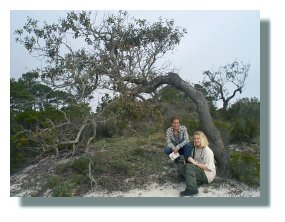 |
Severe erosion is taking this barrier island that now has tree stumps protruding out of tidal pools. We took the beach route to the Audubon Bird Sanctuary. The transition form beach to hardwood forest made for a short lesson in ecology. We added scores of Yellow Rumped Warblers and a Great Egret to our list on this hike.
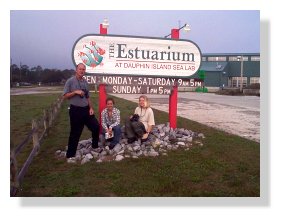 |
The students were surprised to discover a fresh water lake on the island. Mature Live Oak trees were shaped by the salty winds and gave the inner Sanctuary a somewhat eerie appearance. |
|
Our next stop was a tour of the Dauphin Island Sea Laboratory Estuarium. I always enjoy seeing the Bottle-nosed Dolphin articulated skeleton that hangs in the entrance way of the Estuarium. The arm and hand bones of this little mammal teach a fascinating lesson in biology. |
 |
 |
Next we hit the airport and its salt marshes. A Little Blue Egret soon followed a Snowy Egret and then we spent a long time solving the hardest birding puzzle of the trip. It took the arrival of the adult male for us to lean back and laugh about how we were almost tricked by a family of immature Red-breasted Mergansers. |
Our last stop on the Island was a real favorite for Amber and Kelly. The Marine Resources Division Deparrtment of Fisheries Building and the USDA Seafood Laboratory are both located on a series of oyster mounds created hundreds of years ago by the natives of the Island. A small hardwood forest with birding trails exists on some of the inland mounds. A very old Live Oak tree captured our attention and appreciation for the area.
| Judson student and biology major, Sherra Kyser Shivers (JC' 85), conducted an honors thesis research project at the U.S.D.A. Seafood Laboratory where she discovered an episode of cholera in oysters. |  |
Off we raced to the birding platform located on the west side of the Battleship Alabama State Park. This two-story platform is positioned out in the mud flats of Mobile Bay. One has an outstanding view of hardwoods, mud flats, salt marsh, and the Delta.
 |
The unexpected quality of the facility and the perfect view of such wonderful bird habitat excited us. Mobile is 50% low in rain fall for the past year. In normal wet years, this birding platform would allow one to be right on top of some great and infrequently seen shorebirds. |
|
From the platform we spotted large numbers of White Ibises, Green-winged Teals, a Tricolored Heron, Gadwall ducks, large numbers of Great Egrets, American Coots, and a Ring-necked duck. |
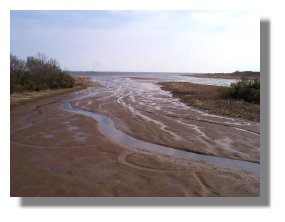 |
The Blakeley Island Mud Lakes were our next birding station. It took a lot of time, phone calls, paper work, and effort for me to arrange for our group to be allowed on the Blakeley Island property. Once there, we were amazed at the site and the great birding. This area is a mountain of mud created from the tailings of dredging the Mobile ship channels. We had to climb a tall dirt wall to the top of the area.
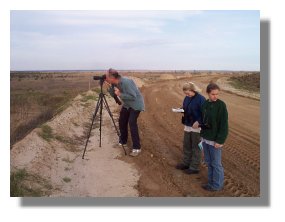 |
We then hiked about a mile to an overlook into the great expanse of the Delta saltmarsh. Birding was spectacular, even in the worst drought in recent time. |
|
Our spotting scope saved the day. In the far distance, we observed hundreds of wading birds, ducks and shore birds. We added a Louisiana Heron to our list along with a Northern Shoveler duck. We enjoyed watching a pair of huge Nutria rodents scamper across the mudflats. The mud lakes were a bazaar scene. We were atop of small, man-made mountain overlooking the State Docks, huge loaded barges, and giant Mobile River industries, and the long, futuristic Chocheron Bridge spanning the river with the flat Delta marshes all around us. |
|
Our birding marathon was over and we headed home. In all we listed 47 species of birds. I added two birds to my personal life list…the Louisiana Heron and the Red-breasted Merganser. We were tired but thrilled with our birding adventure. We plan a return trip when the songbird migration starts in early spring. |
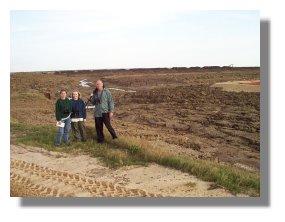 |